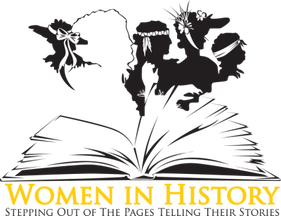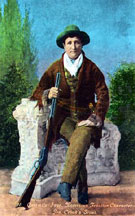WOMEN IN HISTORY - "CALAMITY JANE" CANNARY
A lone woman in the wilds of the Rocky Mountain west
DATE OF BIRTH
May 1, 1852
|
PLACE OF BIRTH
Princeton, Missouri
|
DATE OF DEATH
August 1, 1903
|
PLACE OF DEATH
Terry, South Dakota
|
FAMILY BACKGROUND
Martha Jane Cannary Burke (or Marthy) was the oldest of six children, having two brothers and three sisters, born to Robert and Charlotte Cannary. Both of her parents were born in Ohio. In 1865, the family emigrated over five months with a wagon train from Missouri to Virginia City, Montana. Her mother died along the way in Black Foot, Montana, in 1866. Shortly after arriving in Virginia City, the family left in the spring of 1866 for Utah, arriving at Salt Lake City in the summer. They remained there a year, until her father died in 1867. As the oldest child, Martha Jane took over as head of the family and took them to Fort Bridger, Wyoming Territory, arriving in May 1868. From there, they traveled to Piedmont, Wyoming, on the Union Pacific Railroad.
EDUCATION
In the frontier country she grew up in, Martha Jane likely received little or no formal education
ACCOMPLISHMENTS
Martha Jane set herself apart from other women in that she could work and socialize with hard and tough frontiersmen: from digging for gold, drinking in bars, cussing and dressing like a man, she was mostly accepted by them. As a young child, she loved adventure and the outdoors and became an expert rider at a young age. On her family's emigration trip, while 13 years old, Martha Jane apparently could already "cuss as fiercely as any man" and had "learned to like the taste of whiskey," writes biographer Doris Faber. As Martha Jane wrote in her brief autobiography in 1896: “I figure if a girl wants to be a legend, she should just go ahead and be one.”
BIBLIOGRAPHY
- Commire, Anne, editor. Women in World History: A Biographical Encyclopedia. Waterford, Conn.: Yorkin Publications, 1999-2000.
- DeFran, Dora. Low Down on Calamity Jane. Stickney, SD: Argus Printers, 1981.
- Faber, Doris. Calamity Jane: Her Life and Her Legend. Boston: Houghton Mifflin, 1992.
- Krohn, Katherine E. Women of the Wild West. Minneapolis: Lerner Publications Co., 2000.
- Mueller, Ellen Crago. Calamity Jane. Laramie: Jelm Mountain Press, 1981.
- Riley, Glenda, editor. By Grit & Grace: Eleven Women Who Shaped the American West. Golden, Co., Fulcrum Pub., 1997.
- Riley, Glenda, editor. Wild Women of the Old West. Golden, Co.: Fulcrum Pub., 2003.
- Sanford, William R. and Carl R. Green. Calamity Jane: Frontier Original. Springfield, N.J.: Enslow Publishers, 1996.
- Sollid, Roberta Beed. Calamity Jane : A Study in Historical Criticism. Helena, MT: Montana Historical Society Press, 1995.
CITATION
This page may be cited as:
Women in History. Martha Jane "Calamity Jane" Cannary biography. Last Updated: 1/16/2013. Women In History Ohio.
<http://www.womeninhistoryohio.com/martha-calamity-jane-cannary.html>
Women in History. Martha Jane "Calamity Jane" Cannary biography. Last Updated: 1/16/2013. Women In History Ohio.
<http://www.womeninhistoryohio.com/martha-calamity-jane-cannary.html>

